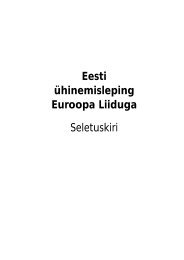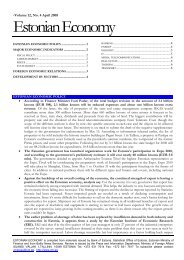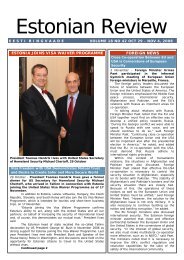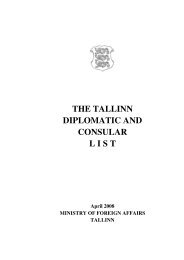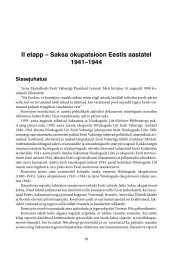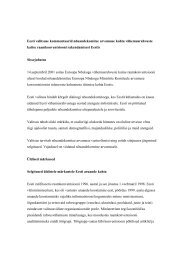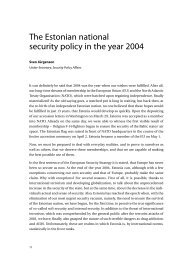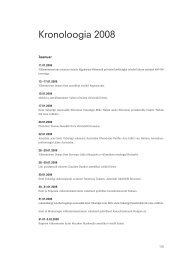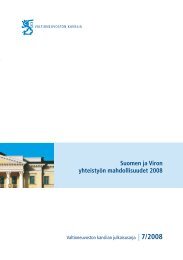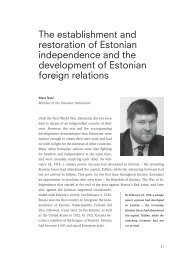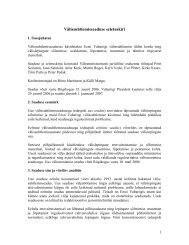Opportunities for Cooperation between Estonia and ... - Valitsus
Opportunities for Cooperation between Estonia and ... - Valitsus
Opportunities for Cooperation between Estonia and ... - Valitsus
Create successful ePaper yourself
Turn your PDF publications into a flip-book with our unique Google optimized e-Paper software.
envisaged. It would be ideal if a student with a lower university degree taken<br />
in one country could pursue further studies in the other country without any<br />
entry barriers. The <strong>Estonia</strong>n <strong>and</strong> Finnish education ministries should determine<br />
the possibilities <strong>for</strong> harmonizing teaching programmes. Creation of joint PhD<br />
programmes should be encouraged <strong>and</strong> contacts <strong>between</strong> institutions providing<br />
doctoral training should be intensified.<br />
Useful models <strong>for</strong> cooperation in education <strong>and</strong> research is provided by the<br />
twin science city project launched by Helsinki <strong>and</strong> Tallinn <strong>and</strong> the Helsinki<br />
Education <strong>and</strong> Research Area arrangement involving nine universities <strong>and</strong><br />
nine polytechnics in the metropolitan area <strong>and</strong> southern Finl<strong>and</strong>. Naturally,<br />
the institutes of education in other regions in both countries should also be<br />
involved.<br />
In a globalized world, institutes offering higher education should be able<br />
to open their doors to students <strong>and</strong> scientists from other countries as well.<br />
Universities around the world compete <strong>for</strong> talent. As a result of falling birth<br />
rates, the number of students in <strong>Estonia</strong> is expected to decline sharply within a<br />
few years. When approximately 60,000 future university students are currently<br />
studying in senior high schools in <strong>Estonia</strong>, the number of prospective university<br />
students, i.e., young peopled aged 16 to 18, will have fallen to around 30,000<br />
by 2016.<br />
Although people in <strong>Estonia</strong> <strong>and</strong> Finl<strong>and</strong> think that their education systems enjoy<br />
high international appreciation, the number of <strong>for</strong>eign students <strong>and</strong> teachers<br />
in the two countries remains modest. For example, in 2006 there were around<br />
5,400 <strong>for</strong>eign students in Finl<strong>and</strong> while the corresponding figure <strong>for</strong> <strong>Estonia</strong><br />
was less than one thous<strong>and</strong>. <strong>Estonia</strong>n <strong>and</strong> Finnish universities <strong>and</strong> the local<br />
conditions are little, if at all known, in most parts of the world.<br />
Since 2000, universities operating in the Baltic Rim area have engaged in close<br />
cooperation in education <strong>and</strong> research. It is based on a network named The<br />
Baltic Sea Region University Network <strong>and</strong> administered by the University of<br />
Turku.<br />
Cross-Border University, a joint project involving several Finnish universities<br />
<strong>and</strong> managed by the University of Joensuu, offers instruction in English mainly<br />
<strong>for</strong> Russian students. <strong>Estonia</strong>n universities could participate in these activities<br />
as well.<br />
<strong>Estonia</strong>n <strong>and</strong> Finnish universities could pool their resources to establish offices<br />
in countries playing a key role in global developments such as China <strong>and</strong> India.<br />
29



